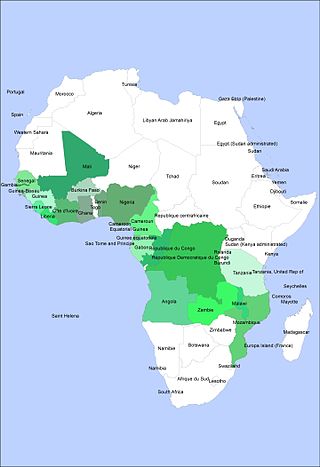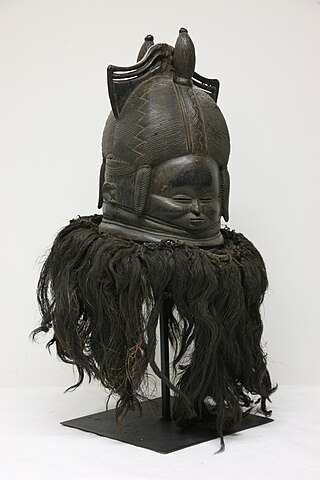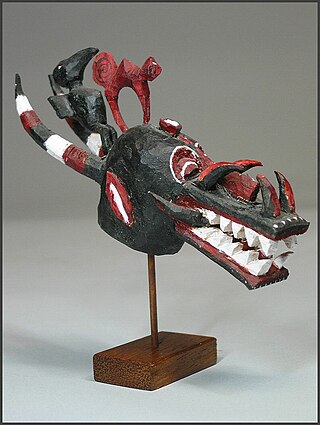
Egungun, in the broadest sense is any Yoruba masquerade or masked, costumed figure. More specifically, it is a Yoruba masquerade for ancestor reverence, or the ancestors themselves as a collective force. Eégún is the reduced form of the word egúngún and has the same meaning. There is a misconception that Egun or Eegun is the singular form, or that it represents the ancestors while egúngún is the masquerade or the plural form. This misconception is common in the Americas by Orisa devotees that do not speak Yorùbá language as a vernacular. Egungun is a visible manifestation of the spirits of departed ancestors who periodically revisit the human community for remembrance, celebration, and blessings.

The Mende are one of the two largest ethnic groups in Sierra Leone; their neighbours, the Temne people, constitute the largest ethnic group at 35.5% of the total population, which is slightly larger than the Mende at 31.2%. The Mende are predominantly found in the Southern Province and the Eastern Province. The Mende are mostly farmers and hunters. Some of the major cities with significant Mende populations include Bo, Kenema, Kailahun, and Moyamba.

The Bassa people are a West African ethnic group primarily native to Liberia. The Bassa people are a subgroup of the larger Kru people of Liberia and Ivory Coast. They form a majority or a significant minority in Liberia's Grand Bassa, Rivercess, Margibi and Montserrado counties. In Liberia's capital of Monrovia, they are the largest ethnic group. With an overall population of about 1.05 million, they are the second largest ethnic group in Liberia (18%), after the Kpelle people (26%). Small Bassa communities are also found in Sierra Leone and Ivory Coast.

The Gẹlẹdẹ spectacle of the Yoruba is a public display by colorful masks which combines art and ritual dance to amuse, educate and inspire worship. Gelede celebrates “Mothers”, a group that includes female ancestors and deities as well as the elderly women of the community, and the power and spiritual capacity these women have in society. Focusing not only on fertility and motherhood but also on correct social behavior within the Yoruba society.

The Poro, or Purrah or Purroh, is a men's secret society in Sierra Leone, Liberia, Guinea, and the Ivory Coast, introduced by the Mane people. It is sometimes referred to as a hunting society and only males are admitted to its ranks. The female counterpart of the Poro society is the Sande society.

The Yaka are an African ethnic group found in southwestern Democratic Republic of the Congo, with Angola border to their west. They number about 300,000 and are related to the Suku people. They live in the forest and savanna region between the Kwango River and the Wamba River. They speak the Yaka language).
The Gola or Gula are a West African ethnic group who share a common cultural heritage, language and history and who live primarily in western/northwestern Liberia and Eastern Sierra Leone. The Gola language is an isolate within the Niger–Congo language family. As of 2015, it is spoken by about 278,000 people.

Sande, also known as zadεgi, bundu, bundo and bondo, is a women's initiation society in Liberia, Sierra Leone, Guinea and the Ivory Coast. The Sande society initiates girls into adulthood by rituals including female genital mutilation. It is said by its supporters to confer fertility, to instill notions of morality and proper sexual comportment, and to maintain an interest in the well-being of its members throughout their lives.

Traditional African masks play an important role in ceremonies, rituals, and masquerades across West, Central, and Southern Africa. Ceremonies in which masks are worn include harvest celebrations, funerals, rites of passage, weddings, and coronations. In some societies, masks and masquerades are also used to settle disputes and communal conflicts.

Most African sculpture was historically in wood and other organic materials that have not survived from earlier than at most a few centuries ago; older pottery figures are found from a number of areas. Masks are important elements in the art of many peoples, along with human figures, often highly stylized. There is a vast variety of styles, often varying within the same context of origin depending on the use of the object, but wide regional trends are apparent; sculpture is most common among "groups of settled cultivators in the areas drained by the Niger and Congo rivers" in West Africa. Direct images of African deities are relatively infrequent, but masks in particular are or were often made for traditional African religious ceremonies; today many are made for tourists as "airport art". African masks were an influence on European Modernist art, which was inspired by their lack of concern for naturalistic depiction.
The Luvale people, also spelled Lovale, Balovale, Lubale, as well as Lwena or Luena in Angola, are a Bantu ethnic group found in northwestern Zambia and southeastern Angola. They are closely related to the Lunda and Ndembu to the northeast, but they also share cultural similarities to the Kaonde to the east, and to the Chokwe and Luchazi, important groups of eastern Angola.
Christianity is the predominant religion in Liberia, with Protestantism being its largest denomination. Liberia is a secular state and its constitution guarantees freedom of religion.
The Songye people, sometimes written Songe, are a Bantu ethnic group from the central Democratic Republic of the Congo. They speak Songe language. They inhabit a vast territory between the Sankuru/Lulibash river in the west and the Lualaba River in the east. Many Songye villages can be found in present-day East Kasai province, parts of Katanga and Kivu Province. The people of Songye are divided into thirty-four conglomerate societies; each society is led by a single chief with a Judiciary Council of elders and nobles (bilolo). Smaller kingdoms east of the Lomami River refer to themselves as Songye, other kingdoms in the west, refer to themselves as Kalebwe, Eki, Ilande, Bala, Chofwe, Sanga and Tempa. As a society, the people of Songye are mainly known as a farming community; they do, however, take part in hunting and trading with other neighboring communities.
Madam Yoko or Mammy Yoko was a leader of the Mende people in Sierra Leone. Combining advantageous lineage, shrewd marriage choices and the power afforded her from the secret Sande society, Yoko became a leader of considerable influence. She expanded the Mende Kingdom and at the time of her death, she was the ruler of the vast Kpa Mende Confederacy.

Nyau is a secret society of the Chewa, an ethnic group of the Bantu peoples from Central and Southern Africa. The Nyau society consists of initiated members of the Chewa people, forming the cosmology or indigenous religion of the people. Initiations are separate for men and for women, with different knowledge learned and with different ritual roles in the society according to gender and seniority. Only initiates are considered to be mature and members of the Nyau.
Religion in Guinea is approximately 89% Muslim, 7% Christian, with 2% adhering to indigenous religious beliefs in 2022. There are also smaller numbers of Atheists and practitioners of other religions in the country. Much of the population, both Muslim and Christian, also incorporate indigenous African beliefs into their outlook.

Art in Sierra Leone has a long and significant tradition of carving and ceremonial works like masks and cloth for initiation and protection. Although art styles are oftentimes ascribed to a single ethnic group, the styles and processes are spread throughout the country and many artists move between the different ethnic groups in the country.

The Bushong Kuba are responsible for some of the most beautiful and sophisticated masquerade or dance traditions in Africa.
The Senufo people who live along the Ivory Coast in Africa created the ceremonial drum. The drum represents various aspects of tradition and life for certain Senufo communities. The construction of the drum is particularly indicative of the roles of women within Senufo communities and how they are seen as "preservers of life" those that hold up the structure and spirituality which govern their world. In fact, of the four Senufo societies, which educate and govern the individual acts of people, the divination governing sandogo society is composed mostly of women. It is worth noting that Senufo culture is matrilineal and certain societal positions such as the artisans, are determined by matrilineal inheritance. While ruled by elder male leaders, one's place in society, as well as their position for the future, is determined by the lineage of the mother. The ceremonial drum owned and housed in the Art Institute of Chicago epitomizes Senufo culture, and it is through drum's embellished designs that viewers are exposed to core beliefs of the Senufo, particularly, in how women are seen as guardians of divinity and supporting foundations of society for the Senufo.

The kponyungo is a ritual mask created by the Senufo people, an ethnolinguistic group residing in Africa's Ivory Coast.















